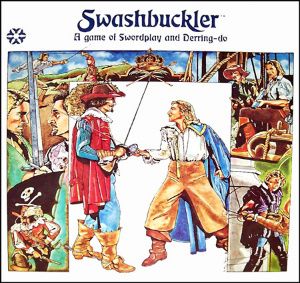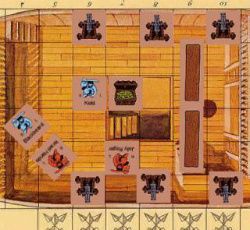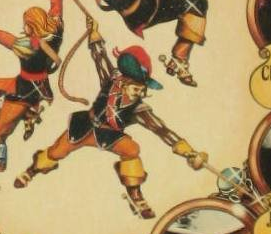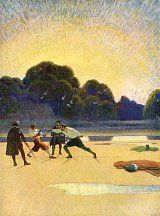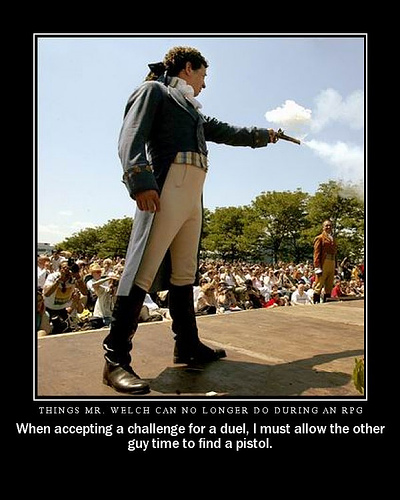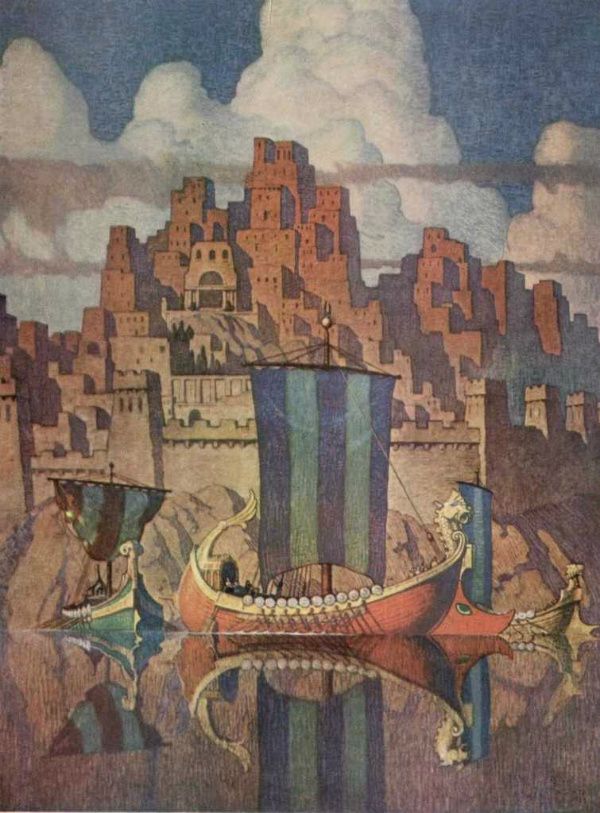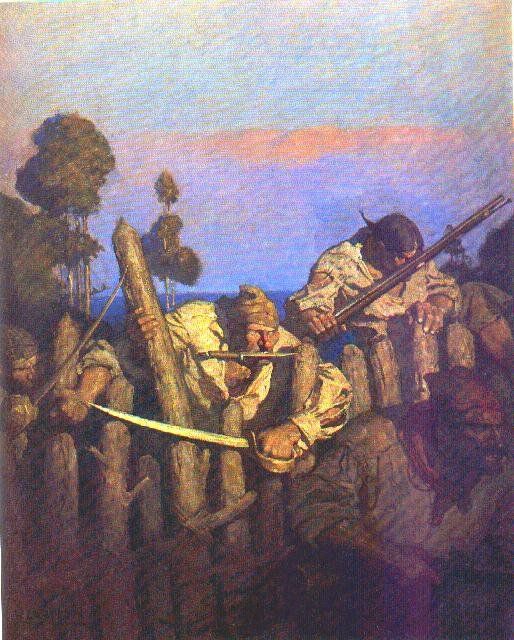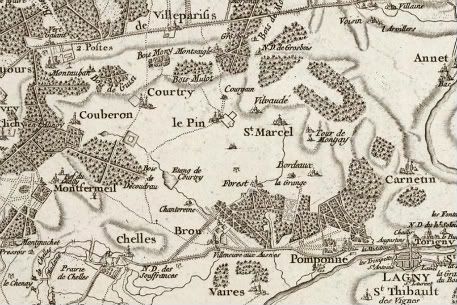"You know my first attack. My second makes you invincible. Attack me. Parry in septime, riposte, envelop in quatre, beat forearm! Take blade as you change arm - disarm. To the forehead!"Many cape-and-sword roleplaying games offer players the opportunity to utilize special abilities or combat maneuvers as their characters gain experience. In 7th Sea, for example, Swordsmen characters study different schools of fencing which give access to Skills and Knacks as well as Techniques which are specific to Mastery of a particular school. Honor + Intrigue characters learn Dueling Styles, each of which includes a Final Secret. Combat skills in Swashbuckler - the roleplaying game by Jim Dietz, not the Yaquinto Publishing board game - build on one another, with Slash progressing to Backhand Slash to Two-Handed Slash and Jab to Thrust to Lunge, for example.
"You can't pierce the forehead."
"You can. Right here."
The exact benefit of specials and maneuvers in these games varies; for example, Mastery of the Lucani style in 7th Sea allows a character to make a combination attack using both a broadsword and a fist, while the Final Secret of H+I's Spanish Style is allows a free Parry on the expenditure of a Fortune Point. Learning different schools and styles allows access to different abilities with experience, which can then be used in combination during a fight.
Swashbuckler takes a slightly different tack. The rules posit two "very generalized" fighting styles, the jack of all trades and the specialist. The former is built by taking a wide variety of combat skills while the latter is focused on full progression through a few skills instead.
Inspired more by pure fencing simulation rules like Rapier and Dagger, Flashing Blades takes a somewhat different approach. FB includes various martial skills, including five dueling styles; the dueling styles confer skill in the weapons associated with that style and may offer a bonus to a particular type of martial attack or defense; for example, Italian Style dueling allows a character to use the longsword, rapier, and foil and confers a + 1 bonus to hit on a thrust or lunge and a + 1 parry bonus using an off-hand weapons like a dagger, main-gauche, baton, or buckler. FB also contains a variety of special attacks, such as entangling an opponent in a cloak, disarming, striking to subdue, or making an attack or parry while drawing a sword, as well as a variety of "dirty tricks," including tripping a lunging swordsman, throwing sand in his eyes, or kicking him in the junk! With the exception of Entangle, these special attacks or dirty tricks aren't tied to a particular style, however - they are open to any character to attempt.
This is one of the reasons that I opted for Flashing Blades when I decided to run a cape-and-sword campaign. I don't like roleplaying games which require an inordinate investment of character resources to perform fundamental tasks - the aforementioned Jab to Thrust to Lunge skill progression in Swashbuckler is a glaring example of this - and I strongly prefer rules that are intuitive, where the abstractions are couched in common sense language - 7th Sea's Raises make sense in the context of the rules but are too abstract, pulling me out of the action. Flashing Blades offers me both of these.
What it doesn't offer me is the Nevers thrust.
La botte de Nevers comes from Paul Féval's Le Bossu (The Hunchback), perhaps the second-most popular cape-and-sword novel in France after the Musketeers saga. The description of the Nevers thrust above comes from Phillipe de Broca's brilliant 1997 adaptation of the famous story, taught by Vincent Perez's duc de Nevers to Daniel Auteil's Lagardère. Lagardère pursues Nevers for the purpose of learning the attack which bears the duke's family name, and once in possession of it the swordsman declares he is now, "Immortal!"
I can actually get pretty close to replicating the Nevers thrust using the combat rules as written for Flashing Blades. The attack consists of a parry of a thrust, a strike to subdue on the sword arm as a counter, a disarm, and a thrust to the head. But that's only pretty close - per the rules as written, a disarm is a counter, not an attack, and can only be made following a successful parry, so the opponent must thrust not once but twice in succession.
The higher hurdle is the thrust to the head. Hit location in FB is chosen at the time of the attack, and resolved by 1D20 rolled twice on the hit location table - the result closest to the target is the result. As a result, it's possible to aim for the head and hit the left leg instead, though a more likely result is a wound on the right arm or chest if the head is missed.
In order to make the Nevers thrust work as described by monsieur le duc, then, I could allow a disarm as an attack rather than a counter and eliminate the roll for hit location, automatically allowing the thrust to find the head. That's not at all unreasonable, if the steps are executed successfully in sequence: parry a thrust, counter, disarm, thrust.
And voilà! My campaign has the Nevers thrust.
This also opens up an interesting house rule possibility for the players, to develop their own special maneuvers for their characters. As a ground rule, let's say this requires that the character is a Master or Master Superior to develop a special maneuver. The special maneuver is a sequence requiring a minimum of two combat rounds composed of some combination of fencing and brawling attacks, footwork, parries, special attacks, or dirty tricks, which must be performed in order successfully. If the special maneuver is performed successfully, then the character gets an additional die to roll for hit location per round required to complete the sequence; if any action in the sequence is not performed successfully - an attack is parried, for example - then they are simply resolved normally per the rules as written. A special maneuver is 'paid for' with an earned Expertise point, and at least two checkmarks for the Expertise point must come from actual duels, not sparring in the salle d'armes.
Let's see how this might look in practice. Vulmea's Surgical Strike consists of parrying an opponent's slash and countering with a vicious kick in the first round, followed by a handful of sand thrown in the eyes and a slash to the head in the second. (Of course it's not gentlemanly. Pirate, remember?) If the sequence of parry, brawling attack, dirty trick, and fencing attack is executed successfully, I get to roll four dice instead of two for hit location, improving my odds of splattering brains on the deck.
I like this. It engages the rules as written, preserving both the crunch and the flavor that led me to choose Flashing Blades in the first place, and it puts the players in charge of developing special maneuvers as simple or as complex as they want them to be like Swashbuckler, rather than a one-size-fits-all approach like 7th Sea's schools or H+I's styles.
But what about Bonetti's Defense? Can the same thing be done for defensive maneuvers as well? Sure - use a combination of parries, blocks, and footwork, and gain extra dice to roll for parries.
Can a special maneuver be taught? Sure, why not - what's a Master without students, after all? Let's say that a student must have an Expertise of at least 18 - Expert - in order to perform the maneuver and earns one less die than the Master who created the maneuver in the first place, so if anyone else successfully performs my Surgical Strike, they roll three dice for hit location, not four. This provides an additional incentive to develop one's own maneuvers.
I think Lagardère would be pleased.


